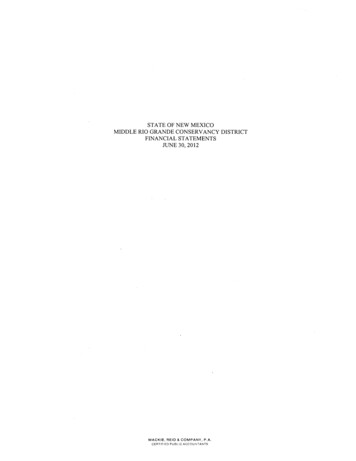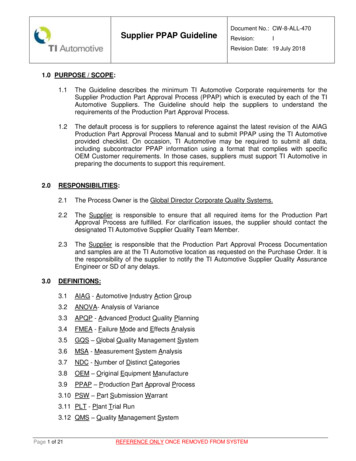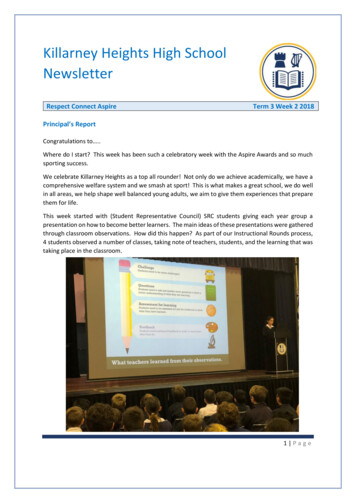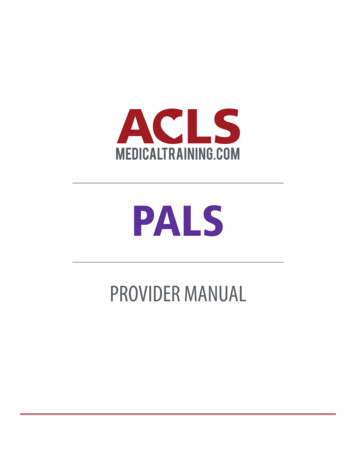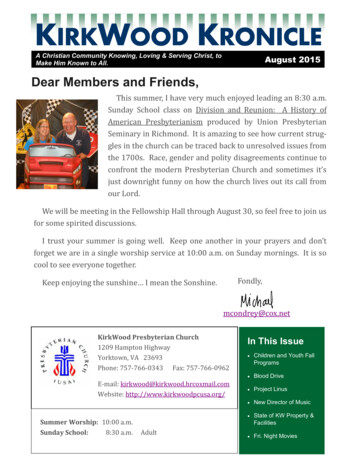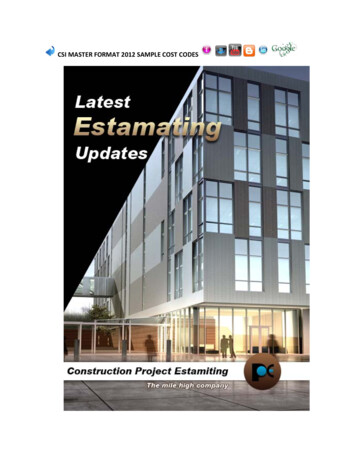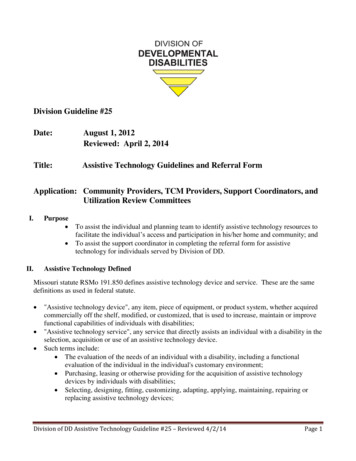
Transcription
Division Guideline #25Date:August 1, 2012Reviewed: April 2, 2014Title:Assistive Technology Guidelines and Referral FormApplication: Community Providers, TCM Providers, Support Coordinators, andUtilization Review CommitteesI.Purpose II.To assist the individual and planning team to identify assistive technology resources tofacilitate the individual’s access and participation in his/her home and community; andTo assist the support coordinator in completing the referral form for assistivetechnology for individuals served by Division of DD.Assistive Technology DefinedMissouri statute RSMo 191.850 defines assistive technology device and service. These are the samedefinitions as used in federal statute. "Assistive technology device", any item, piece of equipment, or product system, whether acquiredcommercially off the shelf, modified, or customized, that is used to increase, maintain or improvefunctional capabilities of individuals with disabilities;"Assistive technology service", any service that directly assists an individual with a disability in theselection, acquisition or use of an assistive technology device.Such terms include: The evaluation of the needs of an individual with a disability, including a functionalevaluation of the individual in the individual's customary environment; Purchasing, leasing or otherwise providing for the acquisition of assistive technologydevices by individuals with disabilities; Selecting, designing, fitting, customizing, adapting, applying, maintaining, repairing orreplacing assistive technology devices;Division of DD Assistive Technology Guideline #25 – Reviewed 4/2/14Page 1
III.Coordinating and using other therapies, interventions or services with assistive technologydevices, such as those associated with existing education and rehabilitation plans andprograms;Training or technical assistance for an individual with disabilities, or, where appropriate,the family of an individual with disabilities; andTraining or technical assistance for professionals, including individuals providing educationand rehabilitation services, employers, or other individuals who provide services to, whoemploy, or who are otherwise substantially involved in the major life functions ofindividuals with disabilities.Considerations/Justifications for Assistive TechnologyThe following questions may help when considering referral for assistive technology: Can assistive technology help maintain the individual in his/her home and community or allowhim/her to return home?Can assistive technology help the individual to perform a function where no other effective meansis available?Can assistive technology increase endurance or the ability of the individual persevere and completetasks?Might assistive technology reduce or prevent additional Medicaid costs such as reducing ormaintaining personal care hours or home health costs?The Support Coordinator must justify in the support plan the individual’s need and desire for the ATdevice and any of the above-mentioned considerations apply.Assistive technology device and/or service will subsequently be referred to as “AT device” in thisguide.IV.Possible Assistive Technology Funding SourcesThere are multiple excellent assistive technology (AT) funding resources available to Missourians withdevelopmental disabilities served by the Missouri Division of Developmental Disabilities. Below aredescriptions and contact information of the more common AT resources.It is indicated in the Division of DD waivers that specialized items and services (e.g., AT) to help theindividual meet his or her needs, shall be accessed and utilized in accordance with the requirement thatstate plan services must be exhausted before waiver services can be provided. DD waiver servicesshall be provided above and beyond any state plan services, including EPSDT that can meet theindividual’s AT needs. Further, DD waiver services shall not duplicate services otherwise availablethrough state plan. Further, State Code of Regulation 9 CSR 45-2.017 Utilization Review Processincludes language : 13) (B) Applicable Medicaid State Plan services shall be accessed first when theindividual is Medicaid eligible and the services will meet the individual’s needs.State plan information is contained below in the AT resources.Division of DD Assistive Technology Guideline #25 – Reviewed 4/2/14Page 2
Is the AT Related to Healthcare?MO HealthNet State Plan ServicesAT that is covered as medically necessary Durable Medical Equipment.Examples of services covered for both children and adults: prosthetics, orthotics, respiratorycare equipment, wheelchairs, hospital beds, augmentative communication devices, hydraulicpatient lifts, etc. Hearing aids are only covered for children under age 21 through state plan.Code of State Regulation for the MO HealthNet Durable Medical Equipment 13csr/13c70-60.pdfMore Information: Missouri HealthNet DME Provider Manual: DME Benefits s/collection dme/Durable Medical Equipment Section13.pdfLink to DME precert/pages/dmeprecert.htmIs the AT related to Education?Elementary and Secondary EducationIDEA – Part C (First Steps)AT that can help a child with a disability, birth to age 3, who has delayed development ordiagnosed conditions that are associated with developmental disabilities. The program retainsownership of the device unless it is customized.Examples: orthotics, prosthetics, therapeutic strollers, other mobility devices; vision andhearing aids; communication devices, adapted toys, switches, etc.More information: DESE webpage on Part C Assistive chassistdoc052810.pdfIDEA – Part B (Elementary and Secondary Education)AT that is needed in order for a child with a disability to receive a free appropriate publiceducation. The school retains ownership of the device.Examples: adaptive computer hardware and software, assistive listening systems, augmentativecommunication devices, magnification devices for reading, etc.Division of DD Assistive Technology Guideline #25 – Reviewed 4/2/14Page 3
Is the AT Related to Employment?MO Division of Vocational RehabilitationAT that can help an eligible individual with a disability secure or keep a job.Examples: hearing aids, vehicle access modifications, home access modifications, computers,adaptive computer equipment or software, prosthetics, orthotics, wheelchairs, walkers, braces,worksite related AT.More Information: Missouri Vocational Rehabilitation Client Services Guide:http://dese.mo.gov/vr/toc.htmRehabilitation Services for the Blind (DSS)AT that can help an individual with a visual disability secure or keep a job.Examples: hearing aids, vehicle access modifications, home access modifications, computers,adaptive computer equipment or software, prosthetics, orthotics, wheelchairs, walkers, braces,worksite related AT.More information: MO RSB Policy and Procedures htmIs the AT related to Telecommunications Access?Telecommunication Access Program (TAP) for Telephone (MoAT)AT that is needed by individuals who have problems using traditional telephone equipmentbecause of their disability.Examples: amplified phones, captioned phones, picture phones, etc.More Information: MoAT TAP Website: http://www.at.mo.gov/tap.htmlTelecommunication Access Program (TAP) for Internet (MoAT)AT that is needed for individuals who have problems using traditional computer equipment toaccess the Internet or e-mail because of their disability.Examples: screen reading software, adaptive keyboards, adaptive mice, voice recognitionsoftware, etc.More Information: MoAT Website: http://www.at.mo.gov/tap.htmlDivision of DD Assistive Technology Guideline #25 – Reviewed 4/2/14Page 4
MO Division of DD Waiver AT Services:Participating Waivers include: Comprehensive, Support, MOCDD, Autism and Partnership forHope.This service includes Personal Emergency Response Systems (PERS), Medication ReminderSystems (MRS), and other electronic technology that protects the health and welfare of theparticipant. This service may also include electronic surveillance/monitoring systems usingvideo, web-cameras, or other technology.Examples: PERS, MRS, and other electronic technology that protects the health and welfare ofan individual.More .pdfMO HealthNet Exceptions Process:AT that is not covered by MO HealthNet may be covered under certain conditions of medicalneed. The item must be needed to sustain the participant’s life, improve the quality of life forthe terminally ill, replace an item or service due to an act occasioned by violence of naturewithout human interference, such as tornado or flood; or be needed to prevent a higher level ofcare.More Information: MO Department of Social Services Website:Exceptions Process Home Page: http://www.dss.mo.gov/mhd/cs/except/V.Assistive Technology AssessmentsA. Assessments DefinedAssessments involve measures or strategies that can include but are not limited to evaluations,device demonstrations, previous device use, and/or trial periods.B. Purpose: To assist the individual to make informed choices about the most appropriate ATdevices to meet his/her need(s); and To provide important information for authorized review entities, e.g., UtilizationReview Committee as they consider AT referrals for approval.C. Qualifications of individuals who or entities that will conduct assessmentsState plan and other resources have formal provider qualification requirements for assessments thatjustify the need for assistive technology offered through that entity.Division of DD Assistive Technology Guideline #25 – Reviewed 4/2/14Page 5
For Division of DD AT referrals, assessments may be utilized to determine appropriateness of ATdevice for the individual. The need for and scope of the assessment and whether a licensedprofessional or other qualified entity to conduct the assessment is warranted will vary on a case-bycase basis. This will depend on such factors as the type of AT device that is being recommendedand the individual’s capabilities and support needs to effectively use the device. A physician’sprescription is not a requirement for the assessment where clearly the request is not directlymedical in nature. Except for those AT devices that require a physician’s prescription and/orassessment by a licensed professional or other qualified entity, it is at the discretion of theindividual and his or her planning team to determine: Whether qualified entities need to provide the assessment justifying the need for the device,and/orWhether other non-licensed sources may provide the justification for the device for all otherrequests.If a particular AT device requires an assessment through a qualified specialist, whether it be alicensed entity or otherwise, the assessment must accompany the referral. Because there are nonationally recognized credentialing bodies for AT Specialists and because AT Specialists’ type andamount of training on a given AT device may vary widely, the qualified specialist needs to havedocumented qualifications as applicable to the AT device being recommended.Qualified AT Specialists are defined as individuals with expertise on the type of assistivetechnology and related alternatives being requested and implemented. AT specialists conductingassessments for a particular AT device must provide evidence of knowledge and expertiseassociated with the AT device, including applicable education, training, and experience.It is the responsibility of the individual planning team and UR Committee to verify that the ATSpecialist possesses the competency to assess for the AT device.Other qualified providers for AT devices may include vendors authorized to consult, install, andmonitor personal emergency response systems, medication reminder systems, and other electronicdevices that serve to enhance one’s independence within his/her home and community and protectshis/her health and safety.When an AT device assessment is indicated for AT device purchases utilizing Division of DDfunding, the assessment shall be completed by a qualified person or entity who has no affiliationwith the provider chosen by the individual to provide the AT device. AT assessments may beauthorized under various services in the DD waiver, to include but not be limited to AssistiveTechnology, Specialized Medical Equipment and Supplies, Environmental AccessibilityAdaptations, Occupational Therapy, Physical Therapy, Speech Therapy, Behavior AnalysisService, Counseling, and Dental.Example:Sally and her planning team in XYZ County want to consider a personal emergency responsesystem to assist Sally in her home. The team is aware of two individuals who can document theirqualifications to conduct a thorough assessment as to how this system can increase Sally’sfunctional independence. Both persons have a minimum of two years experience with availableDivision of DD Assistive Technology Guideline #25 – Reviewed 4/2/14Page 6
products and implementation. Neither person is credentialed as Occupational or PhysicalTherapists. The planning team may choose either individual to assist with device determination.D. Assessment ContentAT device assessments can consist of a formal evaluation, a device demonstration, a device trial,and/or other means of deciding whether an AT device is appropriate to meet an individual’sfunctional needs.Areas to consider during an assessment can include, but are not limited to: Description of the individual’s current abilities/needs that justify the AT device;Description of the level of motivation/desire of the individual/family/caregivers to use theAT device;Review of device(s) considered – (e.g., advantages/disadvantages, features, itemspecifications, any accessories or modifications needed; ease of use, reliability,compatibility with other technologies; maintenance requirements, etc.);Description of when and under what conditions AT device could be used, based on presentand future need and whether it could be used in a variety of settings;Any technical support already addressed above (e.g., whether assistance will be needed forinstallation or setup);Explanations of alternative devices considered and why alternatives could not meet or mosteffectively meet the individual’s need or under what circumstances alternatives might meetthe need;Other resources considered such as equipment loan programs, low tech devices, lessintrusive options, or similar, less costly devices.Assessment documentation shall be provided to the individual and service coordinator to accompanythe UR Committee review materials including referral form.VI.Examples of Assistive Technology Devices that May be Covered through Division of DDItems must relate to the individual’s disability.Hearing aids for adultsPersonal Emergency Response SystemMedication Reminder SystemRemote MonitoringGlobal Positioning System (GPS)Assistive technology that is specifically designed for communication but is not covered understate plan Adaptations to computers if it is determined to be the most appropriate solution to meet theidentified AT need Applicable computer software to meet the identified AT needs (e.g., text to speech software)Note: Division of DD Assistive Technology Guideline #25 – Reviewed 4/2/14Page 7
Hand-held computer devices:o Describe how the device will support the individual’s identified functional limitation(s).Device benefits include but are not limited to helping the individual to better control hisor her own environment and protect health and safety; Include an explanation of any computer software for the device that supports theunique needs of the individual.o As per AT Guidelines, documentation verifying all other funding and other deviceresources have been pursued as applicable prior to requests for funding through thewaiver;o One-time device purchase per individual based on identified need;o Device warranties will be considered on a case-by-case basis;o Devices shall become the individual’s property;o The Division of DD is under no obligation to replace or repair devices;o Internet access shall not be included unless required to ensure the individual’s healthand safety. Request for funding internet access shall be approved by the RegionalDirector.Adaptive recreational equipment such as bicycles, sleds, swingsItems covered are understood to be necessary and consistent with general expected standards ofcare/support, i.e., not experimental or investigational.VII.Items that are Not Covered through Division of DDThis includes but is not limited to: AT devices covered under state plan or other funding source (e.g., Vocational Rehabilitation,School System) AT devices solely for caregiver convenience will not be authorized Desk top and laptop personal computers Generic computer software not related to the individual’s functional abilities Bean bag chairs Items that add value to property Swimming pools Hot tubs Security Systems Generators Memberships to fitness clubs Generic physical fitness equipment (e.g., treadmill, exercise bike) Massage tables Generic children’s car seats Cell phone and minutes Gaming devicesDivision of DD Assistive Technology Guideline #25 – Reviewed 4/2/14Page 8
VIII.Remote MonitoringRemote monitoring includes the use of video, web cameras, motion sensor devices, door alarms, and/orother technology that enables a person to be more independent and less reliant on staff to be physicallypresent with him or her at all times, in particular for night time supports. This includes equipmentutilized for two-way communication between the person receiving supports and the remote monitoringprovider. A significant and necessary off-site monitoring component is the availability of back-upsupports (natural supports and/or staff) for prompt response (within 20 minutes or less) as needed inthe vicinity where the person resides.As per Assistive Technology service definition in the DD waiver manual: Remote monitoring is available on an individual, case-by-case basis when an individualrequests the service and the planning team agrees it is appropriate and meets the health andsafety needs of the individual. Individuals in the waiver interested in remote monitoringtechnology must be assessed for risk following the Division’s risk assessment guidelines postedat http://dmh.mo.gov/docs/dd/riskguide.pdf and must be provided information to ensure aninformed choice about the use of remote monitoring equipment versus in-person support staffand all must be documented in the ISP. Remote monitoring technology may only be used with the full consent of the individual andhis/her guardian and review by Human Rights Committee to ensure due process. The assistive technology to be utilized should be evidenced based, and shall not beexperimental. The type of equipment and location of monitoring devices will depend upon the needs andwishes of the individual and his/her guardian (if applicable), and will also depend upon theparticular company selected by the individual or guardian to provide the equipment. The installation of video monitoring equipment in the home will be done at the direction of theindividual. If the home is shared with others, the equipment will be installed in such a manner that it doesnot invade others’ privacy. The remote monitoring device is controlled by the waiver individual and can be turned on oroff as needed. Any devices authorized under the Assistive Technology service shall not duplicate servicesotherwise available through state plan.o Costs under the Assistive Technology service are limited to 3,000 per individual’sISP year. Exceptions are allowed to this annual spending limit with approval fromthe Regional Director or designee.Required remote monitoring content in ISPUse the Division of DD AT Guideline to assist in decision making, especially sections onconsiderations/justification, and assessment content: Statement to justify rationale for remote monitoring, such as how it benefits person, assureshealth and safety, promotes independence, etc. Also, justify the need for any other service suchas Personal Assistant Group for purposes of remote monitoring using video equipment (SeeAuthorizations section below). Verification that the risk assessment was completed and reviewed by planning team todetermine remote monitoring is sufficient to meet health and safety needs of individual.Division of DD Assistive Technology Guideline #25 – Reviewed 4/2/14Page 9
Documentation of risk assessment shall be included in the file. Below is a link to the MODivision of Developmental Disabilities Risk Screening Guide.http://dmh.mo.gov/docs/dd/riskguide.pdf Describe the remote monitoring equipment function and purpose, features, general location ofequipment, individual and family knowledge of and how to use equipment, (e.g., turning onand off, how to set sensors at night, etc.).Detailed back up plan description in the event of system failure (e.g., equipment malfunction).There must be an emergency/back-up responder plan in the event the individual needs a personto respond to their residence. The emergency plan can include natural supports or paidsupports. If a paid support responder is needed it may be funded through Community Specialistservice or Personal Assistant service. If remote monitoring is occurring in the natural home thepaid responder can be authorized through Personal Assistant or Community Specialist.Community Specialist can only be authorized for the paid support responder for individualsreceiving residential habilitation service (e.g., ISL).o As per the planning team, a detailed plan for response at the individual’sresidence or other location covered by remote monitoring to include at aminimum description of: Two-deep supports (natural supports and/or staff). Response time as per requirements. In situations requiring a person torespond to the individual’s residence, the response time should notexceed 20 minutes. Response type includes face-to-face and/or telephone, depending on howto optimally respond to the individual’s particular need at that time – andto assure health and safety. In emergency situations, monitoring staff should call 911. Documentation of the event.Times remote monitoring can be turned on and off by the individual in a given day.CIMOR Authorizations If using non-video sensory monitoring the service may be authorized under the assistivetechnology service for both equipment purchase/rental and monitoring. If monitoring involves video:o Equipment rental/purchase shall be through Assistive Technology service.o Personal Assistant group service may be authorized for staff that will bemonitoring the screens at the remote monitoring site. Personal Assistant groupservice for remote monitoring in the home may be authorized only for personswho are not receiving a residential habilitation service (e.g., ISL). Community Specialist service or Personal Assistant service may be authorized to assist theindividual if the individual is not utilizing natural supports for emergency response at the locallevel. If the individual receives residential habilitation (e.g., ISL) and remote monitoring isoccurring in the home, the remote monitoring responder shall not be authorized throughPersonal Assistant service. It can be authorized through Community Specialist. An additionaloption for ISL setting may be the remote monitoring response through direct service hours. The ISP shall describe and justify the purpose of these aforementioned services.Division of DD Assistive Technology Guideline #25 – Reviewed 4/2/14Page 10
Staff to Individuals Served RatiosIndicate ratio of a staff person who will be directly monitoring the individual via monitoringequipment, to individuals served for all times in the day (e.g., ratio of 1:4 from 8 a.m. to 5 p.m.). IfPersonal Assistant, Group is authorized for staff to provide video remote monitoring, and the staff toindividuals’ ratios exceeds 1:6, in addition to the justification documented to ensure the health andsafety of the individual, the documentation must show permission was granted by the RegionalDirector or designee. Note: The only activity associated with Personal Assistant, Group service thatcan exceed the 1:6 staffing ratio is when it applies to remote monitoring. With the exception of the hours 8 p.m. to 8 a.m., ratios for purposes of remote monitoring shallnot exceed one staff to up to six persons monitored. This includes individuals served byDivision of DD or other funders. For hours ranging from 8 p.m. to 8 a.m., staff ratios for purposes of remote monitoring shall notbe more than 1:15. This includes individuals served by Division of DD or other funders. Indicate if and describe how persons other than those served by Division DD will be monitoredby the staff, if applicable.Remote Monitoring Provider RequirementsThere shall be a written agreement as to provider roles and responsibilities with remote monitoring.The agreement includes at a minimum: The mainframe is housed at the provider’s service location. Monitoring system design requirements - Equipment and connections meet requirements in theAssistive Technology service definition. Video monitoring requires a high speed internet connection be installed in the individual’shome. Support coordinators are encouraged to check into TAP for Internet, a service throughMissouri Assistive Technology, before requesting that internet service be funded through theDD waiver. Monitoring base staff shall have no other duties other than general supervision and protectiveoversight for individuals they are authorized and assigned to monitor at remote locations. Remote monitoring occurs in real time by awake staff. Immediate availability of additional staff qualified to conduct remote monitoring to serve as abackup should the primary staff need assistance (e.g., concurrent multiple emergencies withpersons monitored). Provider service documentation:o Tied specifically to the service as outlined in the ISP.o Daily notes to verify service provision.o Start and stop timeso Indicate if the monitoring was uneventful, e.g., “no response needed”.o If, for example, a sensor alerts the monitoring staff, describe the occurrence thatactivated the sensor, when it happened, who was involved, response, andoutcome. With visual monitoring – anything detected should be reported andinitialed/signed by staff. For monthly flat rates with sensory monitoring only--provide monthlysummary even if nothing happened; indicate by breakdown of days of“no response needed”.o Describe any communication between staff and individual.Division of DD Assistive Technology Guideline #25 – Reviewed 4/2/14Page 11
o Signatures of all staff involved in monitoring over the course of time. Staff initials for the time segments each was directly involved inmonitoring during that time frame, if applicable.o Staff attendance logs.o Provider monthly summary.o Complete any incident reports as applicable.IX.Instructions for Completing the MO Division of Developmental Disabilities AssistiveTechnology Referral FormDivision of DD targeted case management providers shall submit this form along with allapplicable documentation to support the referral, e.g., assessment reports to the review entitiesincluding Utilization Review Committees in order to assist in their reviewing AT services referralsfor approval.Instructions for Completing the Referral FormComplete the top section of the form.AT Device justification (Questions 1-10 below). Please refer to the assessment reports and otherdocumentation collected to assist in completing responses to the questions on the referral form.1. List the AT device being requested.2. Circle all individuals that apply to initiating the need for the AT.3. How will the AT device meet the individual’s unique needs and help achieve desired functionaloutcomes in the support plan, including how the AT device:a. Increases independence such as developing or maintaining personal, physical, social, orwork related skills;b. Increases community inclusion;c. Improves health and safety;d. Reduces the risk of injury to the individual and/or his or her caregiver(s);e. Decreases need for paid supports.4. Provide a description as to how the AT device has been determined to be appropriate for theindividual.a. Is this an AT device the individual desires to utilize?b. Does the individual agree the AT will be of benefit to his or her unique needs?5. Describe the device trial and duration if applicable. Was a device trial needed to justify the ATdevice in order to:a. To learn how to use the features of the AT device?b. To determine ease of use?c. To determine the need for any accessories or modifications?d. To determine the variety of settings in which the AT device could be used?e. To determine the need for technical support and training?6. Will the individual be able to use the device without training?7. Will the family/caregivers be able to use the device without training?Division of DD Assistive Technology Guideline #25 – Reviewed 4/2/14Page 12
a. If AT device training is needed, indicate the type of training, frequency, duration, etc.8. Indicate all other AT devices considered and why these were not selected. Explain how it wasdetermined that the AT device chosen would best meet the needs of the individual compared toother AT devices.9. Describe other resources pursued to fully or partly fund the AT device. These include but arenot limited to information on accessing such entities as Medicaid State Plan, Department ofElementary and Secondary Education, Vocational Rehabilitation, Missouri AssistiveTechnology in addition to the DD resources. If other federal, state, and local communityresources
commercially off the shelf, modified, or customized, that is used to increase, maintain or improve functional capabilities of individuals with disabilities; "Assistive technology service", any service that directly assists an individual with a disability in the selection, acquisition or use of an assistive technology device.


